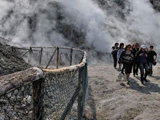|
|
TODAY.AZ / Weird / Interesting
Scientists to drill 13,000ft into active volcano
22 September 2010 [18:30] - TODAY.AZ
 Scientists are planning to drill 13,000ft into the heart of an active volcano in Italy in an attempt to protect the nearby city of Naples by gauging when it is likely to erupt. But experts have warned that the project could trigger an explosion of red hot magma or even an earthquake.
Scientists are planning to drill 13,000ft into the heart of an active volcano in Italy in an attempt to protect the nearby city of Naples by gauging when it is likely to erupt. But experts have warned that the project could trigger an explosion of red hot magma or even an earthquake.The team of scientists wants to insert a borehole inside Campi Flegrei, a huge volcanic formation outside Naples, in the hope of gauging how active it is.
Also known as the Phlegraean Fields, Campi Flegrei is an eight-mile-wide caldera lying west of Naples.
It comprises 24 volcanic fissures and craters – one of which was believed by the ancient Romans to be the home of Vulcan, the god of fire - although much of it lies under water as it extends into the Bay of Naples.
It last erupted in 1538, and recent seismic activity in the area has raised fears that it could be ready to blow again. The project is due to start early next month, when the team will drill 1640ft into the ground at a site in Bagnoli, near Naples. The second phase, due to start in the spring, will involve the drilling of a 4,000 metre deep borehole at the same location.
Scientists will use sensors to measure seismic activity and the temperature of the rock at different depths in an attempt to understand how unstable the area is.
"Calderas are the only volcanoes that can cause truly catastrophic eruptions with global consequences, yet they are still poorly understood," Giuseppe De Natale, the project's coordinator and a geophysicist at Italy's National Institute for Geophysics and Volcanology, told the science magazine Nature.
But there are fears that the experiment, which will tap into 500-600C hot magma, could lead to an eruption which would endanger the 1.5 million people who live in and around Naples.
Benedetto de Vivo, a professor of geochemistry at the University of Naples, said a similar drilling project in Iceland had to be stopped last year after magma was found at a much shallower depth than expected. The Roman towns of Pompeii and Herculaneum were destroyed by a catastrophic eruption by nearby Mt Vesuvius in AD79.
/Telegraph.co.uk/
URL: http://www.today.az/news/interesting/73910.html
 Print version
Print version
Views: 2489
Connect with us. Get latest news and updates.
See Also
- 06 December 2024 [22:20]
Are scented candles harmful to health? - 23 November 2024 [14:11]
Magnitude 4.5 earthquake hits Azerbaijan's Lachin - 20 November 2024 [23:30]
Launch vehicle with prototype of Starship made its sixth test flight - 27 October 2024 [09:00]
Fuel prices expected to rise in Sweden - 24 October 2024 [19:14]
Turkiye strikes terror targets in Iraq and Syria - 23 October 2024 [23:46]
Kazakhstan supplied almost entire volume of oil planned for 2024 to Germany in 9 months - 23 October 2024 [22:17]
Taiwan reported passage of Chinese Navy aircraft carrier near island - 23 October 2024 [21:50]
Russia remains largest oil supplier to India - 16 October 2024 [17:54]
Gamesummit co-founder shares insights on future of gaming industry in Azerbaijan [EXCLUSIVE] - 12 October 2024 [18:27]
TikTok cuts jobs, turns to AI for content moderation
Most Popular
 Pashinyan plants a pig for the Armenians
Pashinyan plants a pig for the Armenians
 Azerbaijan, Russia inks agreement on Development of Transit Freight Transportation
Azerbaijan, Russia inks agreement on Development of Transit Freight Transportation
 Changing global geopolitics & implications for Pakistan
Changing global geopolitics & implications for Pakistan
 U.S. finalizes US$4.7 bln in CHIPS Act subsidy to Samsung Electronics
U.S. finalizes US$4.7 bln in CHIPS Act subsidy to Samsung Electronics
 S. Korea to launch 3rd homegrown military spy satellite
S. Korea to launch 3rd homegrown military spy satellite
 US politicians disgrace themselves with biased scribbles on Garabagh
US politicians disgrace themselves with biased scribbles on Garabagh
 US Senate passes temporary funding bill
US Senate passes temporary funding bill
